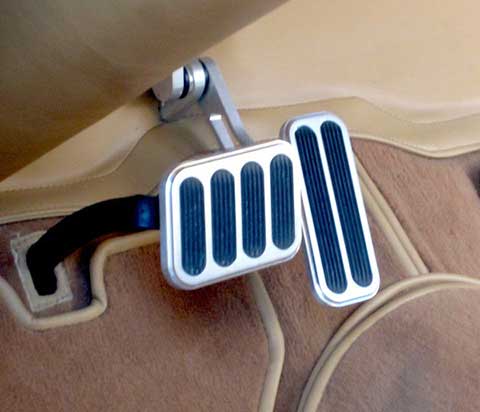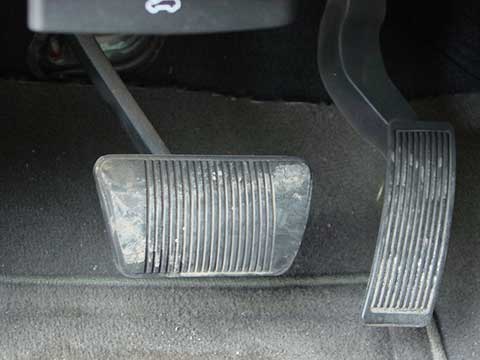When properly operated, the brake pedal will be felt as opposing a certain resistance when pressed. Soft brake pedal or elastic pedal or spongy brake pedal refers to the situation where the brake pedal loses its firmness and is felt soft or unstable.
This problem may occur as a result of several possible situations such as – air penetration at the brake system level, perforation of the brake pipes or exaggerated wear of the calipers. If the brake pedal is felt soft, you should urgently check the braking system of the car and take the necessary measures to prevent any problems in traffic or car accidents.
Contents
What causes a soft brake pedal?
This problem can be caused by a large number of factors or situations. We present below the most common causes and how to solve the problem.
Existence of a leak in the brake lines
Traffic conditions, rust, humidity can lead to the appearance of corrosion and perforations at the level of the brake lines, in which case the liquid will leak to this level. If this problem occurs, you will notice that the brake fluid level will decrease and thus generate a drop in hydraulic pressure.
If you find that the brake pedal is soft, it is best to check the lines and replace them if you notice a leak, which could lead to the phenomenon of soft brakes. Replace damaged brake pipes as soon as possible.
Brake fluid level
If you notice that the brake fluid level is low, you will also notice that the brakes become soft or spongy. In this case, what you can do is lift the hood first and remove the brake master cylinder cover. After removing the cover, check the brake fluid level. If it is low, it is advisable to add extra brake fluid and check the brake situation at this time.
Air at the brake pipe level

Air penetration at the level of the brake pipes is the most common cause of soft brakes. To stop the car from running, its braking system uses hydraulic pressure. For the entire system to run smoothly, it is necessary that there is only brake fluid in the brake pipes.
When the air enters this level, it disrupts the fluid flow in the system, leading to the soft brake pedal phenomenon. The only solution to this situation is to ventilate the brakes.
Brake caliper affected by corrosion
As with brake pipes, the calipers can be affected by corrosion and rust. At the level of the affected areas, the brake fluid will drain, leading to the reduction of hydraulic pressure. If you have noticed that the brakes are softer lately, it is good to check the condition of the calipers.
Brake master cylinder problems
Any problem located at the cylinder level should receive increased attention. In some cases, it may be necessary to change certain components of the braking system. Corrosion and rust can cause perforations through which the brake fluid will leak. As you know, as a result of this loss, the hydraulic pressure will decrease and the brakes will become soft.
Adjusting the rear brake shoes
Because the brake shoes are not helped as they wear out, this will lead to a soft brake pedal feeling.
The shoes should be checked periodically for wear and adjusted as needed. The recommendation of the specialists is to use the hand brake periodically because using it produces an automatic adjustment of the brake shoes.
Brake pads problems
Remove both the front and rear wheels to check for wear on the brake pads. Brake pads are those parts of a vehicle that are responsible for the proper functioning of the entire braking system.
They are the ones that allow the car to stop instantly when we operate the brake pedal. This is the reason why it is good to replace them if they have marked wear.
Worn brake fluid
Used brake fluid is another cause of a soft brake pedal. Over time, the brake fluid can absorb moisture from the air, which can cause the fluid to degrade and stop working properly. Therefore, it is important to periodically remove the liquid completely and replace it with a new one, to ensure its proper functioning.
How to repair soft brakes?

If your brake has become soft or spongy, it would be best to allow a mechanic to perform their technical check. You can also use these tips when your brake has become elastic.
- Press the brake pedal repeatedly – as mentioned above, lowering the hydraulic pressure, no matter what caused it, will result in the elastic brake. In this case, what you can do is repeatedly press the brake pedal. Even in the extreme case where there is a serious problem with the braking system, repeatedly pressing this pedal will cause sufficient pressure to allow you to stop the car safely.
- Check for leakage and try to solve this problem – you can check if there is a brake fluid leak behind the wheels of the car. You can also take a look under the hood to see if there are leaks in the master cylinder or if this area has a certain degree of moisture.
Then it is advisable to check if the master cylinder is filled up to the mark on the tank. If the level is low, it is advisable to add fluid and press the pedal again repeatedly to restore system pressure.
Even if you get a short-term fix to the problem, it is imperative that you come to a car service to check the state of the braking system. - Brake ventilation – Another method you have available to remove excess air from the braking system level is to ventilate them.
If you have overloaded the brakes, either by driving or pulling other cars, the brake fluid may have reached boiling temperatures and have released gases that will make your pedal feel elastic.
This is because gaseous substances, unlike fluids, can be compressed. At the level of the brake calipers and the brake cylinders, you will notice that there are screws that allow the ventilation of the system when you operate the brake pedal. In conclusion, any problem that has arisen in the braking system can lead to major or minor accidents.
Given the existing risks, the most advisable thing would be that, if the brakes seem soft or spongy, you should check the state of the braking system and identify the problem that caused this situation.
